Digital Literacies and Digital Storytelling
Most broadly, digital literacy can be understood as the ability to use digital technology and communication tools to locate, evaluate, use and create information. In his 2004 book, Multiliteracies for a Digital Age, Stuart Selber differentiates three types of digital literacies that are helpful for thinking about the pedagogical possibilities in teaching digital storytelling.
First, functional digital literacy is the ability to use digital technology tools to manage a project or task of some kind. When students use digital tools to scaffold their digital story-making process, they’re practicing functional digital literacy skills.
Next, critical digital literacy is the ability for users to recognize how technologies operate in social and cultural contexts. When students evaluate digital stories, cinematic essays, documentary media, and the choices made by the creators of such works, they are practicing critical digital literacy skills.
Finally, rhetorical digital literacy is the ability to recognize and situate oneself as a user and producer of technological discourses within cultural contexts. Asking students to reflect on whose narratives they’re enabling, for what purposes, and through what means, enables them to develop rhetorical digital literacy.
| Category | Metaphor | Subject Position | Objective |
|---|---|---|---|
| Functional Literacy | Computers as tools | Students as users of technology | Effective employment |
| Critical Literacy | Computers as cultural artifacts | Students as questioners of technology | Informed critique |
| Rhetorical Literacy | Computers as hypertextual media | Students as producers of technology | Reflective praxis |
Multimodal Literacy
“Multimodal Literacy refers to meaning-making that occurs through the reading, viewing, understanding, responding to and producing and interacting with multimedia and digital texts. It may include oral and gestural modes of talking, listening and dramatizing as well as writing, designing and producing such texts. The processing of modes, such as image, words, sound and movement within texts can occur simultaneously and is often cohesive and synchronous. Sometimes specific modes may dominate. For example, when processing screen-based texts the visual mode may dominate whereas the mode of sound may be dominant in podcasts.
There are two significant themes emerging from current research into multimodal literacy and these considerations have implications for classroom practice. The first theme is the effect of the technological changes that are inherent in reading, writing and producing ‘on screen’ compared with reading and writing print-based texts. The second theme is related to the changes that are occurring in the social practices of literacy which have changed and expanded exponentially with the development of Web 2.0 technology. These two themes are now discussed in the light of ongoing research.”
References
Chase, D. (2016). Digital Composition, Storytelling & Multimodal Literacy http://guides.library.stonybrook.edu/digital-storytelling
Walsh, M. (2010). Multimodal literacy: What does it mean for classroom practice. Australian Journal of Language and Literacy, 33(3), 211-239.
Related Scholarly Literature
Feel free to draw from the resources below to further explore scholarly literature related to digital literacies, multimedia learning, and digital storytelling.
 The Cambridge Handbook of Multimedia Learning by Richard Mayer
The Cambridge Handbook of Multimedia Learning by Richard Mayer
“People can learn more deeply from words and pictures than from words alone. This seemingly simple proposition–which can be called the multimedia learning hypothesis–is the main focus of The Cambridge Handbook of Multimedia Learning. Each of the 35 chapters in this Handbook examines an aspect of the multimedia learning hypothesis. In particular, multimedia researchers are interested in how people learn from words and pictures, and in how to design multimedia learning environments that promote learning.”
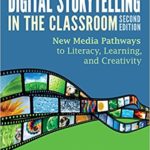
“Combining twenty-five years of experience in the educational technology field with an eye for the future, Ohler connects with people where they are, and helps them see their importance in the future development of living, learning, and working in the Digital Age.”
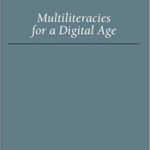 Multiliteracies for a Digital Age by Stuart Selber
Multiliteracies for a Digital Age by Stuart Selber
“Multiliteracies for a Digital Age serves as a guide for composition teachers to develop effective, full-scale computer literacy programs that are also professionally responsible by emphasizing different kinds of literacies and proposing methods for helping students move among them in strategic ways.”
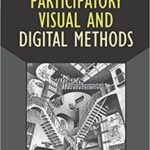
Participatory Visual and Digital Methods by Aline Gubrium and Krista Harper
“Gubrium and Harper describe how visual and digital methodologies can contribute to a participatory, public-engaged ethnography. These methods can change the traditional relationship between academic researchers and the community, building one that is more accessible, inclusive, and visually appealing, and one that encourages community members to reflect and engage in issues in their own communities. The authors describe how to use photovoice, film and video, digital storytelling, GIS, digital archives and exhibits in participatory contexts, and include numerous case studies demonstrating their utility around the world.”
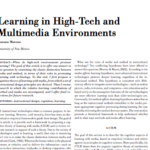 Learning in High-Tech and Multimedia Environments by Roxana Moreno
Learning in High-Tech and Multimedia Environments by Roxana Moreno
“When do high-tech environments promote
learning? The goal of this article is to offer one answer to this question by examining the classic distinction between media and method, in terms of their roles in promoting learning with technology. To this end, I first propose a cognitive theory of learning with media, from which a set of instructional design principles are derived. Then I review research in which the relative learning contributions of method and media are investigated, and I offer final reflections for future research.”
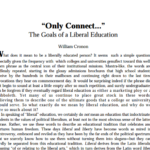
“Only Connect…” The Goals of a Liberal Education by William Cronon
